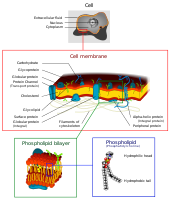
Photo from wikipedia
The central nervous system (CNS) is an important sanctuary site in acute lymphoblastic leukaemia (ALL), and CNS involvement has important prognostic and therapeutic implications. Children with CNS involvement at diagnosis… Click to show full abstract
The central nervous system (CNS) is an important sanctuary site in acute lymphoblastic leukaemia (ALL), and CNS involvement has important prognostic and therapeutic implications. Children with CNS involvement at diagnosis have a poorer prognosis, and even with CNS-directed therapies, ~2 to 8% of paediatric patients relapse in the CNS (Pui et al., 2009). In adults, even with aggressive therapies such as stem cell transplantation, CNS involvement at any time increases risk of CNS relapse and portends worse overall outcomes (Fielding et al., 2007; Aldoss et al., 2016). Many mechanisms contribute to the uniquely important role of the CNS in ALL. The blood–brain barrier (BBB), blood–leptomeningeal barrier (BLMB), and blood–cerebrospinal fluid (CSF) barrier (BCSFB) constitute partial barriers to systemically-administered therapies (Frishman-Levy & Izraeli, 2017), which helps to shield CNS disease. It has also long been known that CNS ALL is predominantly a leptomeningeal disease (Price & Johnson, 1973), a fact that has often been interpreted as reflecting mechanisms of CNS invasion (Williams et al., 2016; M€ unch et al., 2017; Yao et al., 2018). However, it is becoming clear that factors promoting ALL survival and chemoresistance once it has entered the CNS are probably more important than mechanisms of entry into the CNS (Akers et al., 2011; Krause et al., 2015; Gaynes et al., 2017), suggesting that a biologically and clinically significant bona fide CNS niche exists for ALL. Niches are, by definition, complex functional support structures that provide myriad inputs to support the growth and survival of particular cell types. They typically incorporate numerous cell types, soluble factors, and extracellular matrix components along with physical characteristics such as oxygen tension, pH, and temperature (Wang & Wagers, 2011). Consequently, niches can be difficult to characterize, and even more difficult to address therapeutically. Identifying critical niche components is a crucial first step in developing strategies to target them. In the CNS, both cellular and acellular niche components have been identified for ALL. The extracellular matrix protein laminin appears to be required for entry of lymphoblasts into the CNS (Yao et al., 2018). After entry, several CNS stromal cell types are capable of supporting and promoting ALL survival (Akers et al., 2011; Gaynes et al., 2017); this is partly through the expression of membrane proteins such as vascular cell adhesion protein 1 (VCAM1) (Hall et al., 2004) and the elaboration of soluble factors such as interleukins 15 (IL-15) and 7 (IL-7) (Lee et al., 1996; Michaelson et al., 1996). In addition to serving as ALL growth and survival factors, both IL-15 and IL-7 expression also predict CNS involvement (Williams et al., 2014; Alsadeq et al., 2018). In this issue of the British Journal of Haematology, Brasile et al. somewhat surprisingly discover that CSF is toxic to ALL cells. In addition to substantial decreases in proliferation and viability, B(NALM-6) and T(Jurkat) ALL cell lines cultured in CSF manifest increased in reactive oxygen species (ROS) as well as increased apoptotic priming; significantly, this phenomenon is only partially compensated for by supplementation of CSF with fetal bovine serum. These results argue strongly that soluble factors in CSF are directly toxic to ALL cells. Most other studies of the CNS niche have been done using conventional cell culture media in vitro, so this novel finding is a valuable addition to our understanding of the CNS niche. These data beg the question of what specific factors compensate for CSF toxicity in the CNS niche, and the authors confirm that meningeal cells are protective of Band T-lymphoblasts in a contact-dependent manner. They report that leukaemia cell lines and primary Band T-ALL cells cocultured in CSF with primary human meningeal cells (purchased commercially and defined as FN, GFAP, ASMA, and Thy1 1) retain their viability and low levels of ROS. In keeping with other published studies (Akers et al., 2011), this protective effect is dependent on direct cell–cell contact; abrogating cellular adhesion using CXCR4 inhibitor, ICAM1/E-selectin inhibitor, or a transwell system eliminates the benefit of coculture. Correspondence: Leo D. Wang, Department of Immuno-oncology, Beckman Research Institute, City of Hope National Medical Center, Duarte, CA, USA. E-mail: [email protected], [email protected] commentary
Journal Title: British Journal of Haematology
Year Published: 2020
Link to full text (if available)
Share on Social Media: Sign Up to like & get
recommendations!